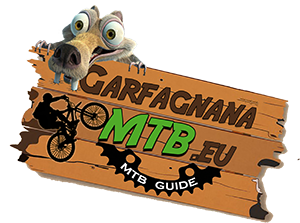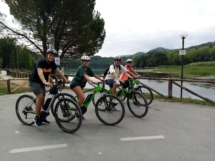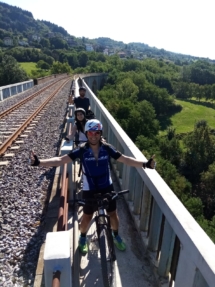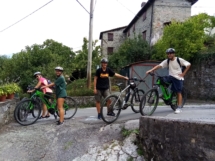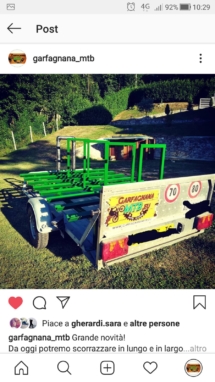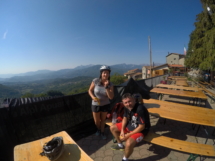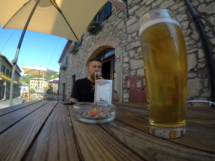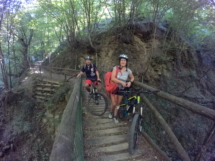Scala difficult paths / levels
TO DESCRIBE THE APPEARANCE TECHNICAL, YOU DEFINE THE FOLLOWING CODES:
TC – MC – BC – OC – EC
It must indicate an acronym for the ascent and one for the descent, separated by a slash (/)
Definition of abbreviations for the description of the technical difficulty the criterion for identifying an abbreviation is the prevalent type of bottom, according to the following caption:
TC (tourist) path on dirt roads from the smooth, compact surfaces, type carriage
MC (for cycle excursionists with average technical skills) path on dirt with little uneven surface or slightly irregular (tractors, cart tracks ...) or on trails with smooth, compact surfaces
BC (for cycle excursionists with good technical skills) route on a very bumpy dirt roads or on mule tracks and trails with rather uneven but smooth enough or irregular but compact, with some natural obstacle (for it. rock steps or roots)
OC (for cycle excursionists with excellent technical skills) as above but on trails with very bumpy and / or very irregular, with significant obstacles
EC (maximum level for bike riders… extreme!) path on very uneven paths, characterized by steps and obstacles in continuous succession, requiring type Dedicated trials techniques
At acronyms can be added to the sign + if there are significant stretches with gradients incurred.
Per “disconnected” means a non-compacted and covered with debris; considering “irregular” a non-sliding soil marked by furrows, steps and / or depressions.
For the determination of the code is taken into account the average path: individual and small areas, attributable to a higher difficulty class, They should not be considered. Any traits no bike, where you need to bring your bike, not contribute to the definition of difficulty.
SCALA STS
The singletrack scale includes six degrees of difficulty, from the lowest to the highest S5 S0. With the singletrack scale only the technical difficulties of a path are evaluated, flat, downhill or uphill that both. The value attributed to a path is chosen mediating between the degrees of difficulty that presents a path for the most part. This does not exclude that a listed path S3, eg, may include traits classified as S2 or S4. The evaluation, Furthermore, considers the trail in dry weather.
The parameters used to draw up the degree of difficulty: type of soil (grip, fluency, geological composition) type of obstacles slope type of curves driving skills required.
As you can see the exposure of a trail and the dangers are not taken into account. Sometimes you can find a sign + after the path classification (is. S2 +). The symbol + It is simply to indicate that the path is slightly harder than a normal path S2, without, however, fit into a classification S3.
S0 – It indicates a single track that does not present particular difficulties. It is mostly sliding paths in undergrowth or on the open plains which have a soil with a good grip, or
stirred little pebbles. In this type of path you will not meet steps on steps, rock or roots. The slope of the path goes from mild to moderate, and the curves are always
large enough. S0 The trail can be traveled without special technical skills.
In short
- Terms of the trail: compact and with good grip ground
- Obstacles: nobody
- Slope: mild to moderate
- Curve: extensive
- Technical level: No special skills
S1 – On a path S1 will just small obstacles like tree roots and small stones. Often the causes of an increase in the degree of difficulty of a course related to the presence of drains or damage caused by erosion. In singletrail S1 soil can sometimes be a little compact. The slope reaches a maximum of 40% and will not meet bends. From the degree of difficulty S1 it is necessary, however, that we know the basic driving techniques and which always maintains a good level of concentration. The most difficult steps require a measured use of the brakes and the ability to affect the trajectory through the displacement of the body. The obstacles can all be overcome with basic driving skills.
In short
- Terms of the trail: can unsecured ground, with small roots and stones
- Obstacles: small obstacles (drains, damage caused by erosion)
- Slope: < 40%
- Curve: narrow
- Technical level: basic skills of driving skills
S2 – Inside the S2 classification they are included paths that are of magnitude greater roots, stones, steps and stairs in very demanding sequence. Often they will meet tight bends almost elbow and slopes that in some passages may reach 70%. The obstacles can only be overcome with a good driving skills. The ability to brake at any time, along with that shift the equilibrium of his own body points, techniques are needed for the S2 level. Equally necessary is knowing how to precisely dose the braking and keeping the body always active while driving.
In short
- Terms of the trail: ground more often than not compact, protruding roots and stones
- Obstacles: various kinds of obstacles and staircases
- Slope: < 70%
- Curve: narrow almost to the elbow
- Technical level: advance
S3 – At S3 category they belong the single trails that have many technical steps made of stone blocks and / or roots. Will meet often stepped high, hairpin bends and difficult slopes and rarely sliding steps. Often we must also deal with a slippery and unsecured ground. There are rare traits with a slope that exceeds the 70%. The steps S3 not require the use of technology in trials, however it requires a good control of the bike and a continuous concentration. Indispensable the ability to brake with good accuracy (then mastered into the brake modulation), and an excellent balance.
In short
- Terms of the trail: technical, Frequently protruding roots and big rocks, slippery and unsecured ground
- Obstacles: steps
- Slope: > 70%
- Curve: tight bends and elbow
- Technical level: more than advanced
S4 – They belong to the category S4 very technical sigletrails that have large blocks of rock and / or steps on particularly demanding roots on land most of the time not very compact. Often they will meet ramps with almost extreme, tight bends and steps, recent high enough to significantly increase the risk of contact with the crowns of the crankset. For these paths it is therefore strongly recommended the use of a
bashguard (paracorona). To be able to cross paths S4 are absolutely necessary trialistiche techniques such as the ability to move the front wheel or the rear (for example into the hairpins), a perfect braking technique and an excellent balance. Only those who love extreme and very technical guide manages to complete a path S4. Most technical steps of S4 type paths are often difficult to overcome even walk.
In short
- Terms of the trail: technical, Frequently protruding roots and big rocks, slippery and do not compact the soil
- Obstacles: steep ramps, terraces very high (often at height of the crowns or more)
- Slope: > 70%
- Curve: tight bends
- Technical level: perfect mastery of the bike and capacity trialistiche techniques such as the displacement of the rear wheel into the hairpins.
S5 – The degree S5 is characterized by a very technical terrain that often presents counterslopes and slippery bottom, curves elbow tight, steps of different sizes that
and follow obstacles like fallen trees. About gradients often extreme. The braking distance is usually very short and sometimes completely absent. the obstacles are often in close sequence. Only the very experienced and safe driver dares steps S5. On this type of paths sometimes obstacles can be skipped. In sharp bends there is often very little space. In certain passages also walk with their shoulders bike is extremely difficult, in some cases, given the slope, you need to hang on to points
balances and, sometimes, even climb.
In short
- Terms of the trail: very technical with counterslopes, slippery and unsecured ground, S5 course may include short sections similar to the high-mountain via ferrata.
- Obstacles: steep ramps, steps are difficult to overcome and in close sequence
- Slope: >> 70%
- Curve: tight hairpins with obstacles
- Technical level: excellent command of technical trialistiche; the movement of the front and rear wheel is only possible in some cases
